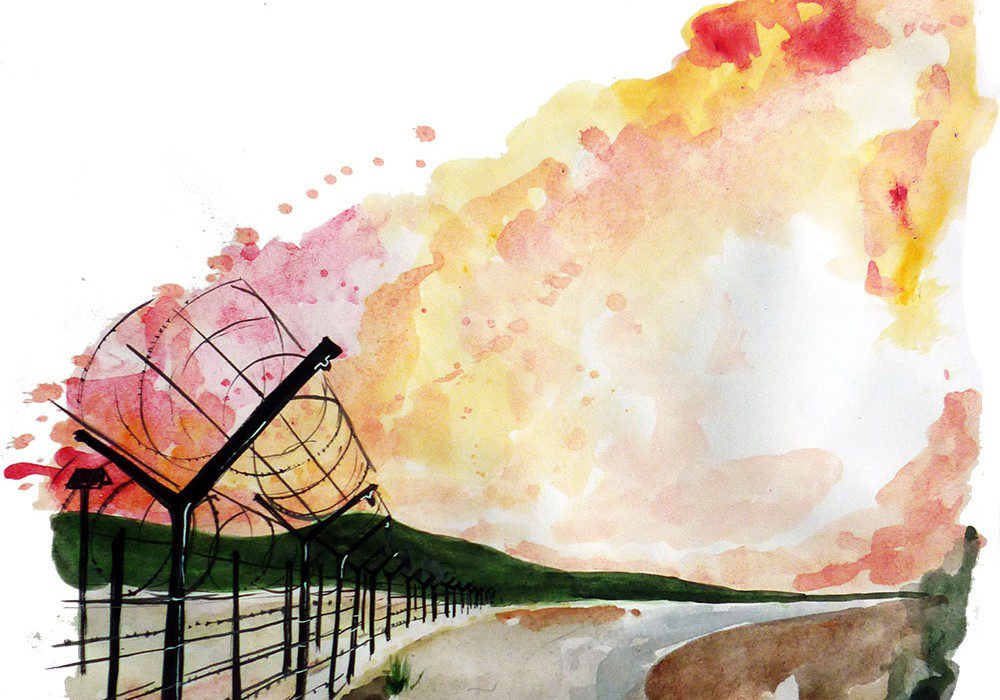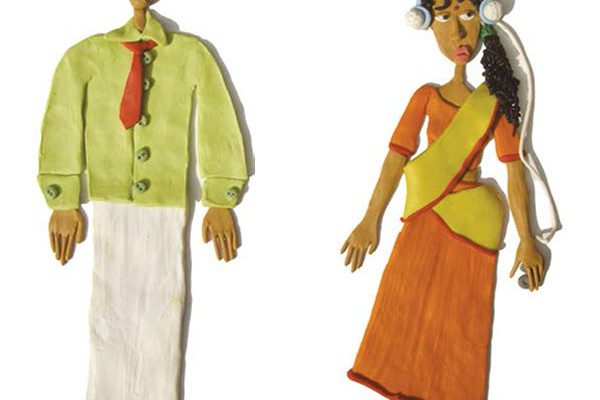Looking at Pakistan from her childhood home in Kashmir, Anuradha Bhasin Jamwal collapses the distance… and the distortion… just a little bit.
Living five kilometers away from the borders, Pakistan in many ways was an intrinsic part of my being. My earliest memories of Pakistan go back to 1971 when I was just three – just some hazy memories of blackouts, smoke rising in the air, people gathering on rooftops to assess the situation hours after the sound of planes, our dug up lawn for trenches in times of emergency but only beneficial for our imaginary games, the visit of an uncle in the army late night dressed in his military fatigues. War ended and so did the memory of an ‘Enemy’ just a stone’s throw away. But Pakistan assumed new forms – quite benign and friendly in nature – through the exceptionally great television shows and dramas, occasional visits of people from across the borders to stay with their divided families in the neighbourhood and, of course, the cricket matches.
India-Pakistan cricket matches evinced a lot of interest even in those lazy non-commercial days, when passions ran high with a tinge of patriotic fervor but never did they turn out to be wars to be waged inside living rooms, everybody glued to television sets or out on the streets and public transport, transistors held like appendages growing out of their ears. They were far too friendly and it wasn’t such a crime to switch over adulatory loyalties from Sunil Gavaskar and Ravi Shastri to Imran Khan and Zaheer Abbas.
Cricket was still a game and not a vehicle for a misplaced sense of national pride and honour. Pakistan was not just an enemy involved in battle frenzy or sporting fervour. It was many things else.
It was a land mass we could see on a clear day from the bridge flanking river the Tawi. And along with that knowledge of borderland in close vicinity are memories of many stories – bitter and sweet – of spies crossing over and becoming victims or local legends, of things popular across the divide being clandestinely smuggled like the famous milk-cake of Abdullian, a village on the international border on the Indian side, much in demand on the other side, of marriage parties crossing over illegally and coming back with a bride further up north in the hilly borderlands of Poonch, of people disappearing on the borders or landing up in jails on the other side in an alien land.
But this alien land was familiar in many ways, especially through the exceptionally brilliant quality of PTV programmes and reception as compared to the lacklustre Doordarshan, whose sole attractions lay in the daily news bulletin, the Sunday movie or the twice a week musical show Chitrahaar. PTV was popular for its bold dramas, even during the very Islamicised orthodox years under Zia-ul-Haq’s regime. It’s entertainment shows, musical programmes had a good variety. It offered a selection of great children’s shows, satires, programmes of literary value and some good entertainment borrowed from the West – Hollywood movies and English television shows. Pakistan appeared quite modern and a rich cultural society; its intelligentsia quite bold in the depiction of various challenging issues in the country including feudalism and patriarchal gender injustice, despite the popular myth of a retrogressive society. Feminist themes were the chore of most of their dramas. Was there any parallel on the Indian side of the many satires of Anwar Maqsood, brilliantly enacted by Moeen Akhtar and Bushra Ansari, some of them courageous takes on the politics of the country?Much of our opinion of Pakistan was constructed on the over-glamourous PTV, far ahead of our poor Doordarshan which began picking up some steam only in the mid-eighties – and this fact may have thrown in some harmless myths of its own, as well. The famous Quiz show Neelamghar with its impressive host Tariq Aziz who in his baritone voice would begin the programme every week with his one-liner, “Dekhti aankhon aur sunte kanon ko Tariq Aziz ka salaam” had enthusiastic participants in his audience and panels, who could churn out couplets of Urdu poetry with enviable ease. Years later, when a long time acquaintance of mine was married to a cousin from Pakistan, his newly wedded bride was expected to rattle off Urdu poetry, much to her embarrassment and poor knowledge of the same.
Occasional visits by people from across the borders filled in some gaps, improving their understanding of a secular society on this side much against the myths perpetuated about India on their side through propagandist media – and school textbooks – as it was on our side. These visits also revealed that our taste for Pakistani television shows and their ghazal singers was matched by their euphoria about Bollywood films, which were smuggled and watched with great fervour.When Pakeezah was screened on Doordarshan in the late seventies, the legendary film was not only popular on this side but also in Lahore. A visitor revealed how people from Faislabad and other areas especially came to Lahore to watch it on the small screen and also talked of a locality in Lahore that witnessed many thefts as people were busy watching the films in neighbours’ homes.
Living in Jammu, our perceptions about Pakistan and its people did not quite fall in line with the opinions about Pakistan that were popular in other parts of India. But there were things that we remained ignorant about – the complexities of Pakistan’s social fabric, the cultural differences within the country, the stark gap between the elite and the commoners, the very thin layered middle class that existed there even as our own middle class grew. We remained even more ignorant of the resilience, struggles and resistance of ordinary people in Pakistan because these were some areas that the state owned PTV did not venture into. It was only my visits to various cities in Pakistan, post 2000, and thereafter, through the power of the social media that this vital ingredient of Pakistan’s society came to be known.
It is a folly, in these interesting times we live in, to remain ignorant of these powerful images and stories and resistance that are taking place in Pakistan. When we on this side take the high moral ground in denouncing Pakistan’s Taliban-isation, its endangered political stability, its weak democracy, its military dictatorships, the increasing spate of bomb blasts and sectarian violence, some of its retrogressive blasphemous and anti-women laws and many other ills, we forget that what makes Pakistan continue to tick is the resilience of Pakistan’s people, the resistance of the known and unknown people who continue to struggle even at the cost of incarceration and persecution. In comparison, India may have had a stronger democracy so far and an economy that sounds much more promising. But don’t we have enough to ponder about in our own backyard – our own brand of communalism, our authoritarian politicians, our home grown saffron terror, our khap panchayats that endorse honour killings, our deep rooted caste system and the deepening gap between the rich and the starving poor? Our problems are not very dissimilar from our those of neighbour, nor any less troublesome.But do we have the courage and an urge for resistance as strong as the one evinced by the likes of I.A. Rehman, Hina Jillani, Asma Jehangir and many, many others continuously laboring against the retrogressive regimes, laws and practices?
Do we have a liberal and independent media that Pakistan has where analysts ruthlessly take on both the powerful political and army elites as well as the Taliban constituents? Perhaps, nothing to match Pakistan’s worth applauding civil society. The last time we saw such a resistance movement in this country was during the Emergency of 1975. In a country where everyone and everything is getting sucked into a glamorous whirlpool through a phenomenon called co-option and manufactured consent, where a strong political-corporate-intelligentsia nexus now dictates the course, another one doesn’t seem to be coming very soon.














